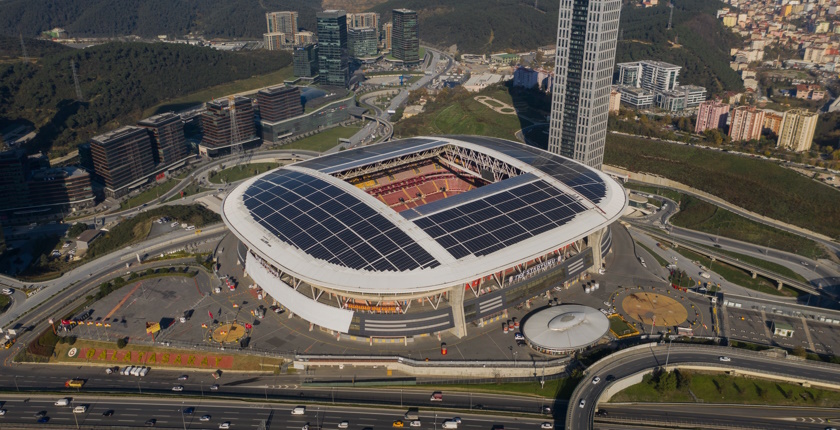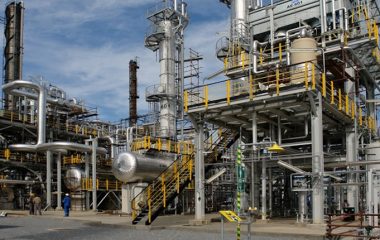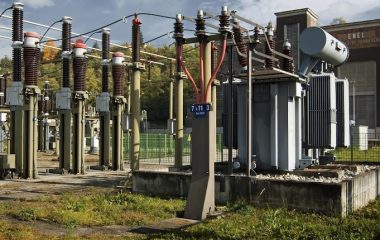
Photo: The 4.2 MW solar power plant that Enerjisa installed on the roof of Galatasaray's Nef Stadium in Istanbul won the Guiness World Records title last year (Guiness World Records / Twitter))
Author: Robert Cathcart, renewable energy researcher, copywriter and blogger
From powering your home to generating the energy required to manufacture your favourite products, solar power can be applied in countless ways. It’s cost-effective and environmentally friendly, so it comes as no surprise that solar is growing at an increasingly rapid rate. In fact, global solar power generation grew an impressive 22% to just over 1 PWh in 2021, according to the International Energy Agency.
In this article, we take a look at how solar power is being applied extensively in the sports world. Although rarely thought of as a sector deeply interested in renewable forms of power production, sport offers a great opportunity for applying solar technologies. Many industry-leading organisations are already investing in solar installations in several key areas.
Stadiums
Stadiums across the globe are home to the biggest and most exciting sporting events. Some of the world’s biggest stadiums reach behemoth capacities of over 100,000 people. From lighting and heating, ventilation and air conditioning (HVAC) systems to massive screens and sound systems, they require considerable energy to run – this is where solar power comes in.
In fact, stadiums are often ideal for solar installations. These are huge structures with plenty of space to install solar panels.
From lighting and HVAC systems to massive screens and sound systems, stadiums require considerable energy to run – this is where solar power comes in
One good example of solar power already being applied to the stadium space is the Mercedes-Benz Stadium in Atlanta, Georgia, in the United States, which has over 4,000 panels installed across the site which will flow back into the grid for use in the local area. Another includes the home of the Philadelphia Eagles (Lincoln Financial Field), which has 11,000 solar panels on site. These are owned by a separate company (NRG), but are available for use in the stadium.
Similarly, in the United Kingdom many stadiums are also investing in solar. This includes Ashton Gate Stadium in Bristol, which installed 460 PV panels as part of a joint initiative with Bristol City Council. Arsenal Football Club’s Emirates Stadium was the first Premier League club to switch to 100% renewable energy partially supplied by solar farms.
Formula E
Formula E is much like Formula 1 except for one distinct difference – the cars are all powered by electricity. This is a much more environmentally friendly alternative. In fact, Formula E has been named as ‘the world’s most sustainable sport’.
The concept behind Formula E is to promote and advance electric vehicles. Their environmental goal is to ensure that all events achieve a 100% renewable energy target.
A primary source of the electricity generated for Formula E is solar. Plus, solar panels are used across the event to power other requirements such as screens and support cars.
Leading the way, Formula E will act as an inspiration for other motorsports. In fact, we are already seeing some other motorsports follow in Formula E’s footsteps. For example, Nitro Rallycross, an American rallycross racing series, already has an all-electric class of race cars which could be powered directly by solar energy.
Swimming pools
It makes sense to use solar power in order to generate heat. So connecting solar panels with water heaters for pools is somewhat of an obvious move.
Swimming pools contain large volumes of water which can take a considerable amount of energy to heat. This is especially true of larger pools used for sports such as Olympic-sized swimming pools, which hold 2.5 million litres of water. This is why a cost-effective method of energy production such as solar power is a great choice for powering heaters.
Sandford Parks Lido, in the UK, has applied for solar power to fight its closure.
Gym equipment
Although not technically a facility where sports are played, gyms play a crucial role in physical preparation for almost every sport in the world. Typically gyms have large energy requirements which range from powering lights, cardio and weight training equipment to screens and sound systems.
When served by traditional forms of electricity production, running gyms can cost a considerable amount. This is why solar panels are becoming an increasingly popular way for gyms to meet their energy needs.
One great example of this is Eco Gym in Rochester, New York. This facility takes a dual approach to energy production, relying both on energy produced through the use of indoor cycling equipment and via a 26 kW rooftop solar PV system alongside two 8.9 kW wind turbines.
This approach allows Eco Gym to be 100% independent of fossil fuel-generated power.
Olympic Games
The Olympic Games have always led the way in the world of sport. Offering the planet’s best athletes an opportunity to showcase their talent and compete on the world’s biggest stage. But recent Olympic Games have also gone one step further, proving to the world that large-scale sporting events can be powered by renewable forms of energy.
In fact, it was reported that the Tokyo 2020 Olympic Games used 100% renewable sources of electricity in the game’s operations. Solar played a major role in this, with a large proportion of the required power generated from solar panels in Fukushima Prefecture.
Legacy venues from the Olympics are also set to benefit from solar power. Recent news has highlighted that London Stadium, which was originally built for the 2012 Olympic games and is now home to Premier League football club West Ham United and UK Athletics, will soon be retrofitted with PV solar panels. This is a step which has been taken to help boost the site’s green credentials.
Solar in sports: summary
We can see that solar energy is already playing a major role in several of the world’s biggest sports. From stadiums to electric vehicles, solar power is helping the sporting world become greener across the board.
With a global focus on drastically reducing carbon emissions in the coming years we are likely to see more sports and sporting venues look to the benefits of solar to support their ongoing processes and facilitate growth.









Be the first one to comment on this article.